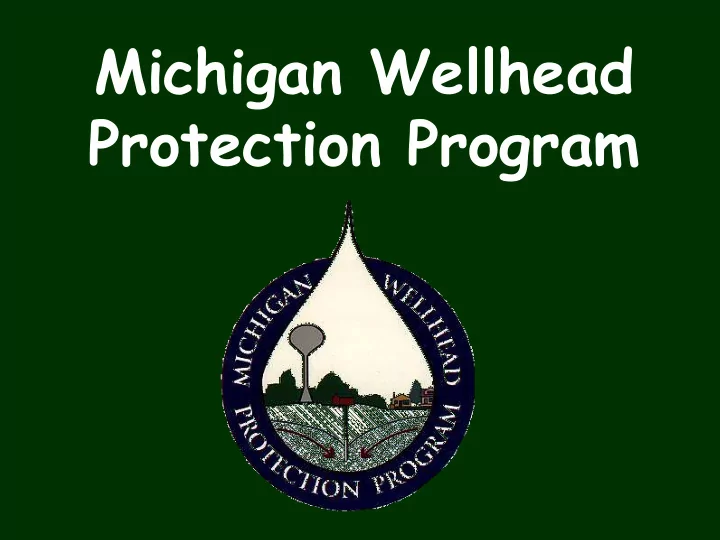

Michigan Wellhead Protection Program
Seven Elements of WHPP 1) Roles and Responsibilities : identify WHPP team 2) Wellhead Protection Area (WHPA): delineate Wellhead Protection Area (WHPA): delineate the area that contributes groundwater to wells the area that contributes groundwater to wells 3) Sources of Contamination : inventory sources of contamination within the WHPA 4) Management : develop methods/plan to manage the WHPA and minimize threat to water supply (e.g. land-use restrictions, BMPs) 5) Contingency Planning : personnel, equipment and procedures to respond to water supply emergencies 6) New Wells : incorporate new sources into WHPP 7) Public Outreach and Education : involve the community – administrators, customers, etc.
WELLHEAD PROTECTION A HISTORICAL PERSPECTIVE JAMESTOWN VIRGINIA’S SOURCE WATER PROTECTION PROGRAM THE PROCLAMATION - 1610 “There shall be no man or woman dare to wash any unclean linen, wash clothes...nor rinse or make clean any kettle, pot or pan, or any suchlike vessel within twenty feet of the old well or new pump. Nor shall anyone aforesaid within less than a quarter mile of the fort, dare to do the necessities of nature, since by these unmanly, slothful, and loathsome immodesties, the whole fort may be choked and poisoned.” Governor Gage
Traditional Approach to Protecting GW Supplies Maintain Isolation Distance from “minor” and “major” sources Minor or Sanitary Protection Radius (septic system, etc.) Community – 200 feet Noncommunity - 75 feet Major - existing and “big potential” contaminant sources Community – 2000 feet Noncommunity - 800 feet (LUST, landfills, environmental contamination (201 Sites), bulk chemical storage)
Wellhead Protection Area (WHPA) The he s surf rface ce a and s subs bsurf rface ce a are rea sur urrounding unding a wa wate ter we well o or we well fie field, d, sup uppl plying ing a pub public ic wa wate ter s syste tem, th through ugh wh whic ich conta ntamina inants nts are reasona nably lik ikely to to move ve to towa ward a d and nd re reach ch such ch water w r well o ll or r wellfield WHPA = 10 year time-of-travel Synonyms: contributing area, capture zone, zone of capture
GW Flow-Based Delineation vs Fixed Radius .5 mi radial circle WHPA - Rockford WHPA Lake Bella Vista
What information is needed to delineate WHPA? • Well Location • GW Elevations • Hydraulic Most Conductivity Important • Pumping Rate
Map GW Elevations high head Yellow lines depict lines of equal low potential head or equivalent head
GW Flow No Pumping Forward Particle Tracking
Calculate Drawdown Simulate Impact of Well 100 Days continuous pumping “ Cone of Depression ”
Superimpose Drawdown Note deflection in potentio- metric surface
Contributing Area to Well GW Flow with Pumping Reverse Particle Tracking
WHPA “10 Yr. Capture Zone”
MGMT M ichigan G roundwater M anagement T ool
MGMT A tool for analyzing groundwater flow using available data • Delineating WHPAs • Contaminant migration • Groundwater flow direction
Why Not Use Existing Information?
Existing Information WELLOGIC Sources MIV GWIM MGMT
NECESSARY INFORMATION (Revisited) • GW Elevation Map • Hydraulic Conductivity • Well Location • Pumping Rate
Available Data WELLOGIC • Water Well Database • ~575,000 Records • Well Locations – Lat/Long • GW Elevations – Land Surface – Static Water Level • K Estimates – Assigned during the GWIM Project – Lithology and Land System based
Information from Water Well and Pump Record Location Location 870 feet AMSL Land Minus Surface Static 20 feet BGL Static Water Elevation = 850 ft amsl Water Elevation Elevation Static Water Level Hydrualic GWIM Project Conductivity Geology K Assignment
Estimate Hydraulic Conductivity “K” Distribution completed for entire state High Medium/High Drift & Medium Bedrock Low/Medium Low
Michigan Other Available Data Geographic Data Library Political boundaries Roads Lakes Rivers Watershed boundaries Air photos Geologic maps etc.
How Do We Map GW Elevations and Determine GW Flow Directions From Available Data?
Potentiometric Surface from WELLOGIC Data Basic Kriging
Data Processing • Using water well records only • Remove noise and data errors – Filtering – Outlier analysis • Kriging – Data interpolation – Smooth surface depicting GW flow
Filtering and Outlier Analysis Obviously wrong Statistically wrong
Potentiometric Surface Comparison MGMT Kriging Standard Kriging
What Did We Do to Show That Our Data Processing Resulted in Correct GW Flow Directions? Comparison Between Field-Generated Maps And MGMT-Generated Maps
FIELD versus MGMT Measured – 66 MGMT – 1737 points points
Comparison between Orientation of Traditional WHPAs and MGMT Maps
GW flow direction Verification Rockford Saranac Coldwater
Compare traditional WHPA delineation with MGMT delineation City of Mount Pleasant
Proposed Uses of MGMT Delineation of “Provisional” WHPAs: Community water supplies without the resources to complete WHPA delineations Nontransient, Noncommunity water supplies Completed district by district Evaluation of new well sites Community Non-Community systems
Note on Provisional WHPAs Traditional WHPAs are differentiated from Provisional WHPAs Wellhead Protection activities in both are eligible for grant funds They do not eliminate the need or value of traditional WHPA delineations
Community Available Data Water Supply Database • 3,450 Wells Lat-Long Locations Confirmed • WHPAs Traditional – 324 Provisional – 897 Low Tritium – 55 Total - 1276
Available Data Nontransient Noncommunity Water Supplies • 1,931 Wells Locations Confirmed • Provisional WHPAs 1434
Pre – MGMT Post – MGMT WHPA STATISTICS WHPA STATISTICS Area of Michigan Type I WHPAs 96,716 mi 2 1270 WHPAs – 1601.22 mi 2 Low Vulnerability Type II NTR WHPAs 53 SWPAs - 158.14 mi 2 1394 WWPAs – 814.46 mi 2 Traditional 329 WHPAs - 646.69 mi 2 Total 2664 WHPAs – 2415.68 mi 2 Total 382 SWPAs or WHPAs WHPAs as Percentage 804.83 mi 2 2.498 % Pre-MGMT: 0.832%
Recommend
More recommend